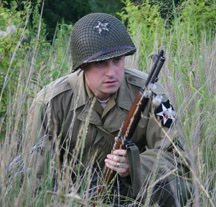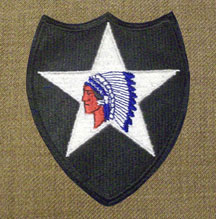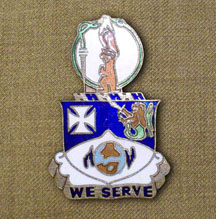On Sunday, April 17th, our group gathered once again at the Strategic Air & Space Museum to help celebrate the Doolittle Raiders 69th Anniversary Reunion. Four of the five surviving Doolittle Raiders took part in the Sunday brunch and autograph signing session, Dick Cole, Tom Griffin, David Thatcher, and Ed Saylor. Bob Hite may have been there earlier but was unable to be a part of the autograph session. Here is a James Deitz print entitled Early Launch that I was fortunate enough to have the Raiders sign. It was an amazing honor to meet these brave men, shake their hand, and give them a heart-felt "thank you."
 April 18, 2011 marks the actual 69th Anniversary of the Doolittle raid. The raid marked the first strike against the Japanese home islands, and was carried out just over four months after the Japanese attack on Pearl Harbor. The raid demonstrated that Japan itself was vulnerable to American air attack and gave Americans everywhere a much needed boost of morale. Sixteen B-25B Mitchell medium bombers were launched from the U.S. Navy's aircraft carrier USS Hornet deep in theWestern Pacific Ocean. The plan called for them to bomb military targets in Japan, and to continue westward to land in China—landing a medium bomber on the Hornet was impossible. All of the aircraft involved in the bombing were lost and 11 crewmen were either killed or captured—with three of the captured men executed by the Japanese Army in China. One of the B-25s landed in the Soviet Union, where it was confiscated and its crew interned for more than a year. Thirteen entire crews, and all but one crewman of a 14th, returned either to the United States or to American forces. This photo shows a B-25 flying off the deck of the Hornet as helmeted Navy personell cheer them on. Despite the fact that none of the B-25 pilots, including Doolittle, had ever taken off from a carrier before, all 16 aircraft launched safely between 08:20 and 09:19.
April 18, 2011 marks the actual 69th Anniversary of the Doolittle raid. The raid marked the first strike against the Japanese home islands, and was carried out just over four months after the Japanese attack on Pearl Harbor. The raid demonstrated that Japan itself was vulnerable to American air attack and gave Americans everywhere a much needed boost of morale. Sixteen B-25B Mitchell medium bombers were launched from the U.S. Navy's aircraft carrier USS Hornet deep in theWestern Pacific Ocean. The plan called for them to bomb military targets in Japan, and to continue westward to land in China—landing a medium bomber on the Hornet was impossible. All of the aircraft involved in the bombing were lost and 11 crewmen were either killed or captured—with three of the captured men executed by the Japanese Army in China. One of the B-25s landed in the Soviet Union, where it was confiscated and its crew interned for more than a year. Thirteen entire crews, and all but one crewman of a 14th, returned either to the United States or to American forces. This photo shows a B-25 flying off the deck of the Hornet as helmeted Navy personell cheer them on. Despite the fact that none of the B-25 pilots, including Doolittle, had ever taken off from a carrier before, all 16 aircraft launched safely between 08:20 and 09:19. Here's the crew of Airplane #1 from the 34th Squadron posing in front of their B-25 (#40-2344) on the deck of the USS Hornet. The crew is Lt. Col. Jimmy Doolittle (second from left), pilot; Lt. Richard E. Cole, copilot; Lt. Henry A. Potter, navigator; SSgt. Fred A. Braemer, bombardier; SSgt. Paul J. Leonard, flight engineer/gunner. Lt. Col. Doolittle's bomber was the first over Japan and the first to drop its bomb load. The four incendiaries fell at 12:30 p.m. (Tokyo time) to incinerate a large factory. Doolittle then flew west to reach the coast of China after dark. By 9:30 fuel was low and unable to find an airfield in the heavy fog, Doolittle ordered his crew to bail out among the mountains of China. He then followed them into the night, his B-25 crashing on a nearby mountainside. The only injury sustained by any of the crew was a sprained ankle. Local Chinese escorted the Americans to Chuchow from where they eventually returned home safely.
Here's the crew of Airplane #1 from the 34th Squadron posing in front of their B-25 (#40-2344) on the deck of the USS Hornet. The crew is Lt. Col. Jimmy Doolittle (second from left), pilot; Lt. Richard E. Cole, copilot; Lt. Henry A. Potter, navigator; SSgt. Fred A. Braemer, bombardier; SSgt. Paul J. Leonard, flight engineer/gunner. Lt. Col. Doolittle's bomber was the first over Japan and the first to drop its bomb load. The four incendiaries fell at 12:30 p.m. (Tokyo time) to incinerate a large factory. Doolittle then flew west to reach the coast of China after dark. By 9:30 fuel was low and unable to find an airfield in the heavy fog, Doolittle ordered his crew to bail out among the mountains of China. He then followed them into the night, his B-25 crashing on a nearby mountainside. The only injury sustained by any of the crew was a sprained ankle. Local Chinese escorted the Americans to Chuchow from where they eventually returned home safely. Here is a B-25 bomber on permanent display at the Air & Space Museum. It has been painted to resemble one of the original Doolittle Raider aircraft.
Here is a B-25 bomber on permanent display at the Air & Space Museum. It has been painted to resemble one of the original Doolittle Raider aircraft. All of the Raiders came through and looked at our exhibit as soon as they arrived. We even got a few comments from them concerning our uniforms and accoutrements. Here Tom Griffin examines our display of wartime U.S. Army gear. It was probably the greatest honor I have ever had during one of our unit display. Simply unforgettable!
All of the Raiders came through and looked at our exhibit as soon as they arrived. We even got a few comments from them concerning our uniforms and accoutrements. Here Tom Griffin examines our display of wartime U.S. Army gear. It was probably the greatest honor I have ever had during one of our unit display. Simply unforgettable! This is an interior shot of a second B-25 that the museum has on display. This B-25 has a metal staircase and walkway running right along the main body of the aircraft. In addition, sections of the fuselage are cut-away so visitors can look right into the bomb bay and other areas of the aircraft. And compared to the B-17 and the B-29, this feels like a very cramped little cockpit.
This is an interior shot of a second B-25 that the museum has on display. This B-25 has a metal staircase and walkway running right along the main body of the aircraft. In addition, sections of the fuselage are cut-away so visitors can look right into the bomb bay and other areas of the aircraft. And compared to the B-17 and the B-29, this feels like a very cramped little cockpit. Here's a life-size bronze bust of Lt. Col. Doolittle with a black and white photo of him used as a backdrop. This was behind glass so there are some interesting reflections and glares in the photo.
Here's a life-size bronze bust of Lt. Col. Doolittle with a black and white photo of him used as a backdrop. This was behind glass so there are some interesting reflections and glares in the photo. Jeff McCue and Matt Hazard look happy to be a part of the morning's activities. Jeff put on his favorite U.S. Navy work uniform and Mr. Hazard sported the Class A Wool Service Coat with khaki shirt and early-war black tie.
Jeff McCue and Matt Hazard look happy to be a part of the morning's activities. Jeff put on his favorite U.S. Navy work uniform and Mr. Hazard sported the Class A Wool Service Coat with khaki shirt and early-war black tie. Ahhhh, campaign hats. Matt and I both love to wear this stylish piece of headgear often associated with drill instructors or stateside training.
Ahhhh, campaign hats. Matt and I both love to wear this stylish piece of headgear often associated with drill instructors or stateside training. Another portrait of Matt Hazard, this time in black and white. The distinctive unit insignias are of the 23rd Infantry Regiment.
Another portrait of Matt Hazard, this time in black and white. The distinctive unit insignias are of the 23rd Infantry Regiment. A portrait of Mr. David Jameson, our unit president. He's wearing a set of mechanics HBTs and the M41 HBT Cap. Time to go work on an airplane!
A portrait of Mr. David Jameson, our unit president. He's wearing a set of mechanics HBTs and the M41 HBT Cap. Time to go work on an airplane! Jeff had to get just the right angle on his white Dixie-cup hat. Jeff's ever-expanding U.S. Navy display keeps getting better and better at every event.
Jeff had to get just the right angle on his white Dixie-cup hat. Jeff's ever-expanding U.S. Navy display keeps getting better and better at every event. Here's Steve Baxter all decked-out in his M42 paratrooper uniform. Looking sharp!
Here's Steve Baxter all decked-out in his M42 paratrooper uniform. Looking sharp! This is our newest member, Eric. He's only just started building his impression but it's looking pretty awesome already. Way to go, Eric!
This is our newest member, Eric. He's only just started building his impression but it's looking pretty awesome already. Way to go, Eric! And finally, a photo of Sergeant Krelle in my khakis and campaign hat. I have a MIVA1 bag under my left arm containing the M2A2 Service Gas Mask. The shoulder sleeve insignia is the Hawaiian Department patch. The Hawaiian Department was the Army's largest overseas department. The Hawaiian Department's two main tasks were to protect the Pacific Fleet from sabotage and defeat any invasion. In April 1941 the Army Chief of Staff assured President Roosevelt: "The Island of Oahu, due to its fortification, its garrison, and its physical characteristics, is believed to be the strongest fortress in the world." If you've ever seen the movie, From Here To Eternity, this is the patch that Burt Lancaster and Montgomery Clift are wearing on their sleeve.
And finally, a photo of Sergeant Krelle in my khakis and campaign hat. I have a MIVA1 bag under my left arm containing the M2A2 Service Gas Mask. The shoulder sleeve insignia is the Hawaiian Department patch. The Hawaiian Department was the Army's largest overseas department. The Hawaiian Department's two main tasks were to protect the Pacific Fleet from sabotage and defeat any invasion. In April 1941 the Army Chief of Staff assured President Roosevelt: "The Island of Oahu, due to its fortification, its garrison, and its physical characteristics, is believed to be the strongest fortress in the world." If you've ever seen the movie, From Here To Eternity, this is the patch that Burt Lancaster and Montgomery Clift are wearing on their sleeve.



